
Anaea aidea, the tropical leafwing, is a species of brush-footed butterfly in the subfamily Charaxinae. Its native range extends from Mexico to northwestern Costa Rica, with strays sometimes seen in southern Texas, Arizona, and California in the United States. Some authors consider Anaea aidea to be a subspecies of Anaea troglodyta.

Anthanassa frisia, the Cuban crescentspot, Cuban checkerspot or Cuban crescent, is a butterfly of the family Nymphalidae. Subspecies tulcis is known by the common names pale-banded crescent or Tulcis crescent; it is treated as a species by some authors.

Calpodes ethlius, the Brazilian skipper, larger canna leafroller or canna skipper, is a butterfly of the family Hesperiidae. It is found in the United States from southern Florida and southern Texas, south through the West Indies, Mexico, and Central America to Argentina. Strays and temporary colonies can be found north to southern Nevada, northern Texas, Illinois and Massachusetts.

Wallengrenia otho, the southern broken dash or broken dash skipper, is a butterfly of the family Hesperiidae. It was originally described by Smith in 1797. It is found from eastern Texas and the southeastern United States, south through the West Indies and Central America to Argentina. Strays can be found as far north as central Missouri, northern Kentucky and Delaware.
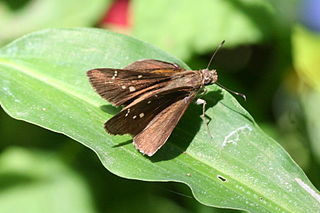
Decinea percosius, the double-dotted skipper, is a species of butterfly of the family Hesperiidae. It is found from Belize north to Mexico. It is an occasional colonist up to the lower Rio Grande Valley in Texas, US.

Texola elada, the Elada checkerspot, is a species of butterfly in the brush-footed butterfly family, Nymphalidae. It is found from southern Mexico north to central Texas and central Arizona in the United States.

Phocides polybius, the bloody spot or guava skipper, is a species of butterfly in the skipper family, Hesperiidae, that is native to the Americas. It is found from the lower Rio Grande Valley of southern Texas in the United States south through Mexico and Central America to Argentina. The species was first described by Johan Christian Fabricius in 1793.

Cecropterus dorantes, the lilac-banded longtail or Dorantes longtail, is a species of butterfly in the family Hesperiidae. It is found from Argentina, north through Central America, Mexico, and the West Indies to southern Texas and peninsular Florida. Strays can be found as far north as northern California, southern Arizona, southern Missouri and North Carolina.
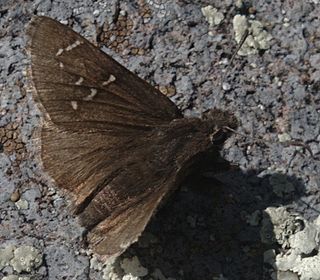
Thorybes mexicana, the Mexican cloudywing, mountain cloudy wing or Nevada cloudy wing, is a butterfly of the family Hesperiidae. It is found in the high elevation mountains of the western United States south into Mexico.
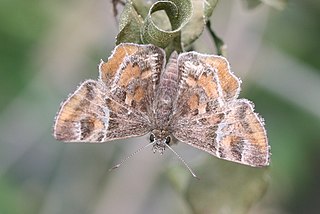
Systasea pulverulenta, the Texas powdered skipper, is a butterfly of the family Hesperiidae. It is found in North America from southern and western Texas, south through Mexico to Guatemala in Central America.

Chiothion asychis, the white-patched skipper or white patch, is a species of butterfly in the family Hesperiidae. It is found from Argentina, north through tropical America to the West Indies and southern Texas. Strays can be found as far north as southern Arizona, Nevada and Kansas.
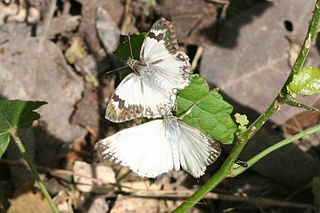
Heliopetes macaira, the Turk's-cap white-skipper , is a butterfly of the family Hesperiidae. It is found from southern Texas in North America, south through Central America to Paraguay.

Celotes nessus, the common streaky-skipper, is a butterfly of the family Hesperiidae. It is found in North America from southern Arizona, southern New Mexico, and western Texas south to northern Mexico. Rare strays can be found up to southern Oklahoma and northern Louisiana.
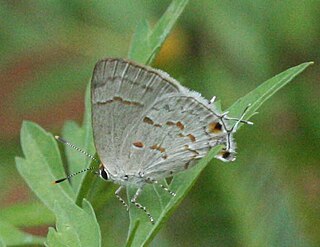
Tmolus echion, the red-spotted hairstreak or larger lantana butterfly, is a butterfly in the family Lycaenidae. It is found from Brazil, north to Sinaloa and Tamaulipas in Mexico. Rare strays can be found in southern Texas. It was introduced to Hawaii in 1902 to control lantana.

Papilio rogeri, the pink-spotted swallowtail, is a butterfly of the family Papilionidae (swallowtails). It is found in central and southern Mexico. One stray has been reported from the lower Rio Grande Valley in Texas, United States.

Eurema boisduvaliana, commonly known as Boisduval's yellow, is a butterfly in the family Pieridae. It is found from Costa Rica north to Mexico. Rare strays may be found in southern Florida, but it is a regular migrant to south-eastern Arizona, south-western New Mexico, and southern Texas. The habitat consists of subtropical forests and forest edges, scrubs, roadsides and pastures.

Pyrisitia nise, the mimosa yellow, is a butterfly in the family Pieridae. It is found from Argentina north to the Texas Gulf Coast and throughout central and southern Florida, northward to the Tennessee Valley. It is an occasional stray to central Texas and south-eastern Arizona and rarely to southern California, southern Colorado and Kansas. The habitat consists of brushy woodland edges.

Rekoa marius, the Marius hairstreak, is a butterfly in the family Lycaenidae. It is found from Paraguay north to Sonora in Mexico. Strays may be found as far north as southern Texas. The species used to be considered rare in the southern Texas. It is the species of Rekoa found in Arizona. The habitat consists of disturbed tropical areas.

Anthanassa texana, the Texan crescentspot, is a species of butterfly in the family Nymphalidae. It is found from Guatemala north through Mexico to southern California, east across the southern United States to northern Florida, Georgia and South Carolina. Strays may be found up to Arkansas, Missouri, Illinois, South Dakota, and central Nevada. The habitat consists of deserts, dry gulches, open areas, streamsides, road edges, and city parks.
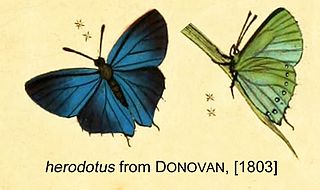
Cyanophrys herodotus, the tropical green hairstreak or tropical greenstreak, is a butterfly of the family Lycaenidae. It was described by Johan Christian Fabricius in 1793. It is found in Mexico, Guatemala, Panama, Nicaragua, Colombia, Ecuador, Peru, Bolivia, Brazil, Paraguay and Argentina. Rare strays can be found as far north as southern Texas. The habitat consists of open disturbed areas in tropical and subtropical rainforests and cloudforests at altitudes ranging from 600 to about 2,000 meters.





















